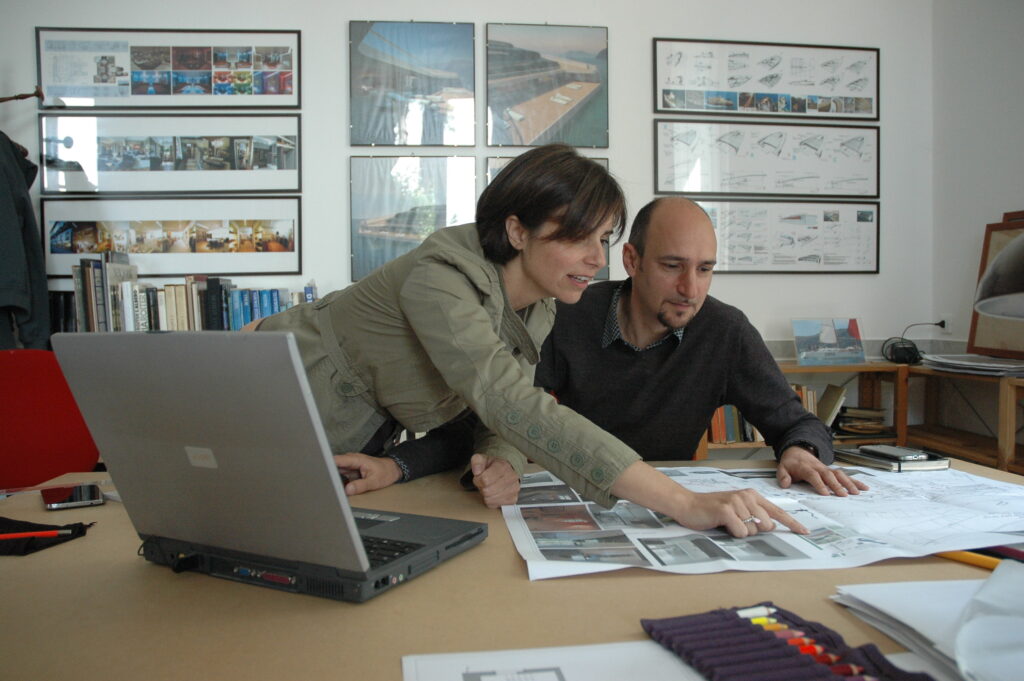Understanding how an architectural practice works and what are its tasks within a project gives greater clarity and better specify what our service can offer.
The architectural practice is the entity that manages a project.
Indeed, the word “management” may be strong and unpleasant as well as authoritarian, but in this case it is absolutely fitting with what really happens in a design practice.
The meaning of management in its broadest sense is “the direction of something …. logistics control, guidance.”
In a strict sense, is: “a set of actions to be taken, so that the company can pursue their aims in business planning and make choices regarding the relations between its constituent elements (people and technology)”.
When reading this definition and thinking it referred to every project that is being developed (managed) in architectural practices, you cannot do anything but stand up and make a tribute to those who have undertaken the arduous task (granted compliment, as those who write belong to the category).
It is therefore time to define what constitutes a project in order to better define its management.
The project, in simplified terms, initially consists of a preparatory phase needed to launch it; contractual documents are developed to formalize a commitment between the implementer and the client, who in this way shake the agreement for the launch of the project and the decision to begin this work.
Secondly begins a phase of evaluation in order to assess whether the concept is valid in reference to the context by defining its profile, the real requirements of the clients are outlined and the real needs of the client and the purpose of the projects is formalized.
The architectural practice ensures that the requirements are expressed in terms of functional analysis and then as technical solutions (specifications).
The economic, organizational and technical feasibility of the project is then analyzed.
The documents for the construction and verification of the work are drafted.
Try to think about the commitment of time, resources, and preparation that a design firm must face every time they work on a project of any size.
Think again, although it is always unpleasant to talk about this, what the “cost” impact could be for such a commitment, complex and constant, on every single project and its realization.
As a design team, we have often found ourselves facing the problems of time and cost that obviously disrupt the quality and commitment of a project.

The designers can often invest too little time in the relationship with the customer, they must solve problems (including administrative), they must try to optimize the available resources such as people and equipment, they must be able to perform a continuous search for market supply to provide the best product and most consistent to his idea, they need to promote their capabilities to new jobs and must continually increase their preparation taking into account that the new regulations require all this.
On the other hand, the “design practice” is just a combination of the words “practice” and “design” but how to dedicate to all these aspects, from practicing construction, studying the profession (and specific codes), practicing relationships with the intermediate figures responsible for the construction of the building?
Our outsourcing service enables the architectural firm to lighten that load of processing required for the performance of design, just taking care of its repetitive and monotonous aspects.
In this way, the design firm has the chance to take care of its customer relations and propose qualitatively and economically appropriate technological solutions to its clients. It has the ability to optimize resources, both the staff and the space and the number of computers and licenses to acquire.
The latter is a typical factor the owner of the design firm must always deal with: big projects obviously require large spaces, more staff and a consequent increase in the structure investment; small projects exactly, but not always in proportion, the reverse. This fact creates internal problems in the design firm, which must assess whether and which projects in order to undertake more and balance better its structure, without creating the inevitable increase and decrease with accordion effect.
The architectural practice, relying on an outsourcing service, has the chance to involve even in those jobs that in other times would not be assessed as convenient to acquire.
The ability to operate on several fronts and projects of different entities of our outsourcing group allows the practice, as holder of the project, to offer a product that is qualitatively and economically favorable:
- quality offered by our expertise and experience carried out in various fields;
- greater investment in research and preparation of new choices and products on the practice side;
- speed in the execution of the projects offered by our outsourcing service based on experience and time optimization for the exchange of the necessary information
- savings in the resources on the side of the architectural practice and cost-effective offers by our outsourcing service to the practice, in order to enable it to remain competitive on the market,
In conclusion, schematizing and as already stated above, the architectural practice has:
- more time to devote to the relationship with the customer
- more space for the promotion of investment in its structure towards new jobs
- more time and energy to invest in research for new technological choices that the market offers
- more time for the documentation and study of new disciplines
- less burden on the growth of professionalism
- less burden on the increase of the structure